Microstructure, Mechanical Properties, and Fatigue Fracture Characteristics of High-Fracture-Resistance Selective Laser Melting Al-Ni-Cu Alloys
Abstract
:1. Introduction
2. Experimental Procedure
3. Results and Discussion
3.1. Microstructure Characteristics
3.2. Tensile Properties and Hardness
3.3. Fatigue Characteristics
4. Conclusions
Author Contributions
Funding
Institutional Review Board Statement
Informed Consent Statement
Data Availability Statement
Acknowledgments
Conflicts of Interest
References
- Osório, W.R.; Peixoto, L.C.; Cante, M.V.; Garcia, A. Microstructure features affecting mechanical properties and corrosion behavior of a hypoeutectic Al–Ni alloy. Mater. Des. 2010, 31, 4485–4489. [Google Scholar] [CrossRef]
- Fan, Y.; Makhlouf, M.M. The effect of introducing the Al–Ni eutectic composition into Al–Zr–V alloys on microstructure and tensile properties. Mater. Sci. Eng. A 2016, 654, 228–235. [Google Scholar] [CrossRef]
- Suwanpreecha, C.; Pandee, P.; Patakham, U.; Limmaneevichitr, C. New generation of eutectic Al-Ni casting alloys for elevated temperature services. Mater. Sci. Eng. A 2018, 709, 46–54. [Google Scholar] [CrossRef]
- Zhuang, Y.; Zhang, X.; Zhu, L.; Hu, Z. Eutectic spacing and faults of directionally solidified Al–Al3Ni eutectic. Sci. Technol. Adv. Mater. 2001, 2, 37–39. [Google Scholar] [CrossRef]
- Uan, J.; Chen, L.; Lui, T. On the extrusion microstructural evolution of Al–Al3Ni in situ composite. Acta Mater. 2001, 49, 313–320. [Google Scholar] [CrossRef]
- Zhang, Z.-G.; Watanabe, Y.; Kim, I. Effect of texture evolution on tensile properties of Al–Ni eutectic alloy fabricated by equal channel angular pressing. Mater. Sci. Technol. 2005, 21, 708–714. [Google Scholar] [CrossRef]
- Spinelli, J.E.; Cante, M.V.; Cheung, N.; Mangelinck-Noël, N.; Garcia, A. SEM Characterization of Al3Ni Intermetallics and its Influence on Mechanical Properties of Directionally Solidified Hypoeutectic Al-Ni Alloys. Mater. Sci. Forum 2010, 636, 465–470. [Google Scholar] [CrossRef]
- Srivastava, N.; Chaudhari, G.P. Effect of ultrasonic treatment on the mechanical behaviour of Al–Ni alloys. Mater. Sci. Technol. 2019, 35, 1239–1247. [Google Scholar] [CrossRef]
- Peng, P.; Zhang, A.; Yue, J. Competitive growth of leading phase and tensile properties of directionally solidified eutectic Al–Ni alloy. Mater. Sci. Eng. A 2020, 773, 138887. [Google Scholar] [CrossRef]
- Zhao, J.-R.; Hung, F.-Y.; Lui, T.-S.; Wu, Y.-L. The Relationship of Fracture Mechanism between High Temperature Tensile Mechanical Properties and Particle Erosion Resistance of Selective Laser Melting Ti-6Al-4V Alloy. Metals 2019, 9, 501. [Google Scholar] [CrossRef] [Green Version]
- Zhao, J.R.; Hung, F.Y.; Lui, T.S. Microstructure and tensile fracture behavior of three-stage heat treated inconel 718 alloy produced via laser powder bed fusion process. J. Mater. Res. Technol. 2020, 9, 3357–3367. [Google Scholar] [CrossRef]
- Chen, K.-J.; Hung, F.-Y.; Lui, T.-S.; Tsai, C.-L. Improving the applicability of wear-resistant Al–10Si–0.5 Mg alloy obtained through selective laser melting with T6 treatment in high-temperature, and high-wear environments. J. Mater. Res. Technol. 2020, 9, 9242–9252. [Google Scholar] [CrossRef]
- Sun, J.; Yang, Y.; Wang, D. Parametric optimization of selective laser melting for forming Ti6Al4V samples by Taguchi method. Opt. Laser Technol. 2013, 49, 118–124. [Google Scholar] [CrossRef]
- Do, D.K.; Li, P. The effect of laser energy input on the microstructure, physical and mechanical properties of Ti-6Al-4V alloys by selective laser melting. Virtual Phys. Prototyp. 2016, 11, 41–47. [Google Scholar] [CrossRef]
- Rickenbacher, L.; Etter, T.; Hovel, S.; Wegener, K. High temperature material properties of IN738LC processed by selective laser melting (SLM) technology. Rapid Prototyp. J. 2013, 19, 282–290. [Google Scholar] [CrossRef]
- Yan, Q.; Song, B.; Shi, Y. Comparative study of performance comparison of AlSi10Mg alloy prepared by selective laser melting and casting. J. Mater. Sci. Technol. 2020, 41, 199–208. [Google Scholar] [CrossRef]
- Ch, S.R.; Raja, A.; Jayaganthan, R.; Vasa, N.; Raghunandan, M. Study on the fatigue behaviour of selective laser melted AlSi10Mg alloy. Mater. Sci. Eng. A 2020, 781, 139180. [Google Scholar] [CrossRef]
- Yu, Y.; Yu, J.J.; Zhang, H.; Zhao, H.B.; Nie, D.R.; Xiao, B.L.; Ma, Z.X. Effects of Heat Treatments on Microstructure and Me-chanical Properties of AlSi10Mg Alloy Produced by Selective Laser Melting. Acta. Metall. Sin. 2020. [Google Scholar]
- Shi, Y.; Yang, K.; Kairy, S.K.; Palm, F.; Wu, X.; Rometsch, P.A. Effect of platform temperature on the porosity, microstructure and mechanical properties of an Al–Mg–Sc–Zr alloy fabricated by selective laser melting. Mater. Sci. Eng. A 2018, 732, 41–52. [Google Scholar] [CrossRef]
- Spierings, A.; Dawson, K.; Dumitraschkewitz, P.; Pogatscher, S.; Wegener, K. Microstructure characterization of SLM-processed Al-Mg-Sc-Zr alloy in the heat treated and HIPed condition. Addit. Manuf. 2018, 20, 173–181. [Google Scholar] [CrossRef]
- Ma, R.; Peng, C.; Wang, R.; Wang, R.; Zhou, Z.; Li, X.; Cao, X. Effect of bimodal microstructure on the tensile properties of selective laser melt Al-Mg-Sc-Zr alloy. J. Alloy. Compd. 2020, 815, 152422. [Google Scholar] [CrossRef]
- Sun, S.; Liu, P.; Hu, J.; Hong, C.; Qiao, X.; Liu, S.; Zhang, R.; Wu, C. Effect of solid solution plus double aging on microstructural characterization of 7075 Al alloys fabricated by selective laser melting (SLM). Opt. Laser Technol. 2019, 114, 158–163. [Google Scholar] [CrossRef]
- Liu, P.; Hu, J.-Y.; Li, H.-X.; Sun, S.-Y.; Zhang, Y.-B. Effect of heat treatment on microstructure, hardness and corrosion resistance of 7075 Al alloys fabricated by SLM. J. Manuf. Process. 2020, 60, 578–585. [Google Scholar] [CrossRef]
- Chen, X.; Liu, K.; Guo, W.; Gangil, N.; Siddiquee, A.N.; Konovalov, S. The fabrication of NiTi shape memory alloy by selective laser melting: A review. Rapid Prototyp. J. 2019, 25, 1421–1432. [Google Scholar] [CrossRef]
- Konovalov, S.; Osintsev, K.; Golubeva, A.; Smelov, V.; Ivanov, Y.; Chen, X.; Komissarova, I. Surface modification of Ti-based alloy by selective laser melting of Ni-based superalloy powder. J. Mater. Res. Technol. 2020, 9, 8796–8807. [Google Scholar] [CrossRef]
- Zhang, L.-C.; Attar, H. Selective Laser Melting of Titanium Alloys and Titanium Matrix Composites for Biomedical Applications: A Review. Adv. Eng. Mater. 2016, 18, 463–475. [Google Scholar] [CrossRef]
- Boussinot, G.; Döring, M.; Hemes, S.; Stryzhyboroda, O.; Apel, M.; Schmidt, M. Laser powder bed fusion of eutectic Al–Ni alloys: Experimental and phase-field studies. Mater. Des. 2021, 198, 109299. [Google Scholar] [CrossRef]
- Churyumov, A.Y.; Pozdniakov, A.V.; Prosviryakov, A.; Loginova, I.S.; Daubarayte, D.K.; Ryabov, D.; A Korolev, V.; Solonin, A.N.; Pavlov, M.D.; Valchuk, S.V. Microstructure and mechanical properties of a novel selective laser melted Al–Mg alloy with low Sc content. Mater. Res. Express 2019, 6, 126595. [Google Scholar] [CrossRef]
- Knoop, D.; Lutz, A.; Mais, B.; Von Hehl, A. A Tailored AlSiMg Alloy for Laser Powder Bed Fusion. Metals 2020, 10, 514. [Google Scholar] [CrossRef] [Green Version]
- Li, J.; Birbilis, N.; Li, C.; Jia, Z.; Cai, B.; Zheng, Z. Influence of retrogression temperature and time on the mechanical properties and exfoliation corrosion behavior of aluminium alloy AA7150. Mater. Charact. 2009, 60, 1334–1341. [Google Scholar] [CrossRef]
- Kim, J.; Jeong, H.; Hong, S.; Kim, Y.; Kim, W. Effect of aging treatment on heavily deformed microstructure of a 6061 aluminum alloy after equal channel angular pressing. Scr. Mater. 2001, 45, 901–907. [Google Scholar] [CrossRef]
- Li, Y.; Brusethaug, S.; Olsen, A. Influence of Cu on the mechanical properties and precipitation behavior of AlSi7Mg0.5 alloy during aging treatment. Scr. Mater. 2006, 54, 99–103. [Google Scholar] [CrossRef]
- Li, J.-F.; Huang, J.-L.; Liu, D.-Y.; Chen, Y.-L.; Zhang, X.-H.; Ma, P.-C. Distribution and evolution of aging precipitates in Al-Cu-Li alloy with high Li concentration. Trans. Nonferrous Met. Soc. China 2019, 29, 15–24. [Google Scholar] [CrossRef]
- Boonchouytan, W.; Chatthong, J.; Rawangwong, S.; Burapa, R. Effect of Heat Treatment T6 on the Friction Stir Welded SSM 6061 Aluminum Alloys. Energy Procedia 2014, 56, 172–180. [Google Scholar] [CrossRef] [Green Version]
- Gao, C.; Liu, Z.; Xiao, Z.; Zhang, W.; Wong, K.; Akbarzadeh, A. Effect of heat treatment on SLM-fabricated TiN/AlSi10Mg composites: Microstructural evolution and mechanical properties. J. Alloy. Compd. 2021, 853, 156722. [Google Scholar] [CrossRef]
- Campbell, F.C. Elements of Metallurgy and Engineering Alloys. ASM Int. 2008, 26, 487–508. [Google Scholar]
- Fan, Y.; Makhlouf, M.M. The Al-Al3Ni Eutectic Reaction: Crystallography and Mechanism of Formation. Met. Mater. Trans. A 2015, 46, 3808–3812. [Google Scholar] [CrossRef]
- Zuo, L.; Ye, B.; Feng, J.; Zhang, H.; Kong, X.; Jiang, H. Effect of ε-Al3Ni phase on mechanical properties of Al–Si–Cu–Mg–Ni alloys at elevated temperature. Mater. Sci. Eng. A 2020, 772, 138794. [Google Scholar] [CrossRef]
- Xia, F.; Gao, X.; Liang, M.; Guo, Y.; Li, J.; Yang, Z.; Wang, J.; Zhang, L. Effect of thermal exposure on microstructure and high-temperature fatigue life of Al-Si piston alloys. J. Mater. Res. Technol. 2020, 9, 12926–12935. [Google Scholar] [CrossRef]
- Xue, Y.; El Kadiri, H.; Horstemeyer, M.F.; Jordon, J.B.; Weiland, H. Micromechanisms of multistage fatigue crack growth in a high-strength aluminum alloy. Acta Mater. 2007, 55, 1975–1984. [Google Scholar] [CrossRef]
- Mohammadi, A.; Enikeev, N.; Murashkin, M.Y.; Arita, M.; Edalati, K. Developing age-hardenable Al-Zr alloy by ultra-severe plastic deformation: Significance of supersaturation, segregation and precipitation on hardening and electrical conductivity. Acta Mater. 2021, 203, 116503. [Google Scholar] [CrossRef]
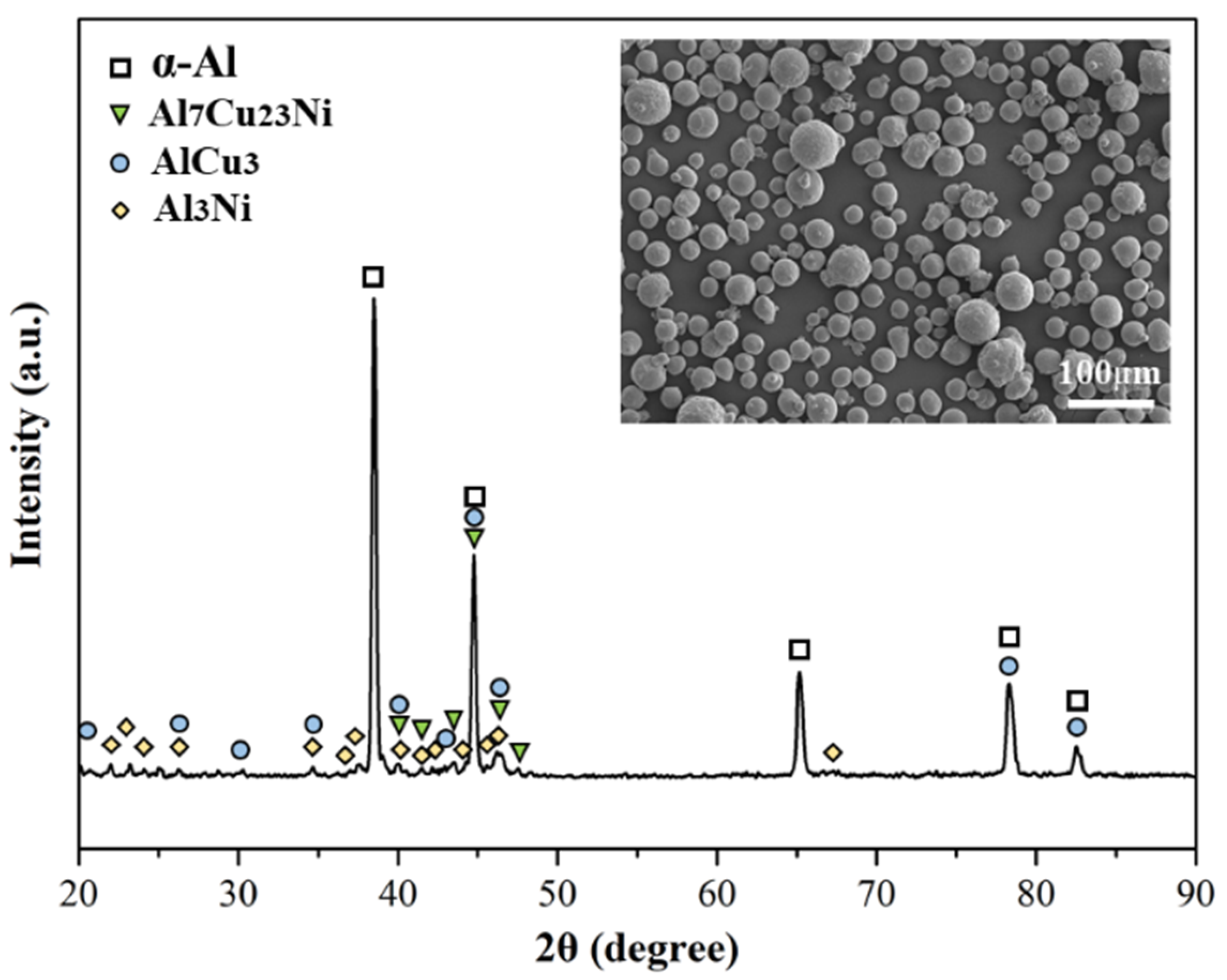
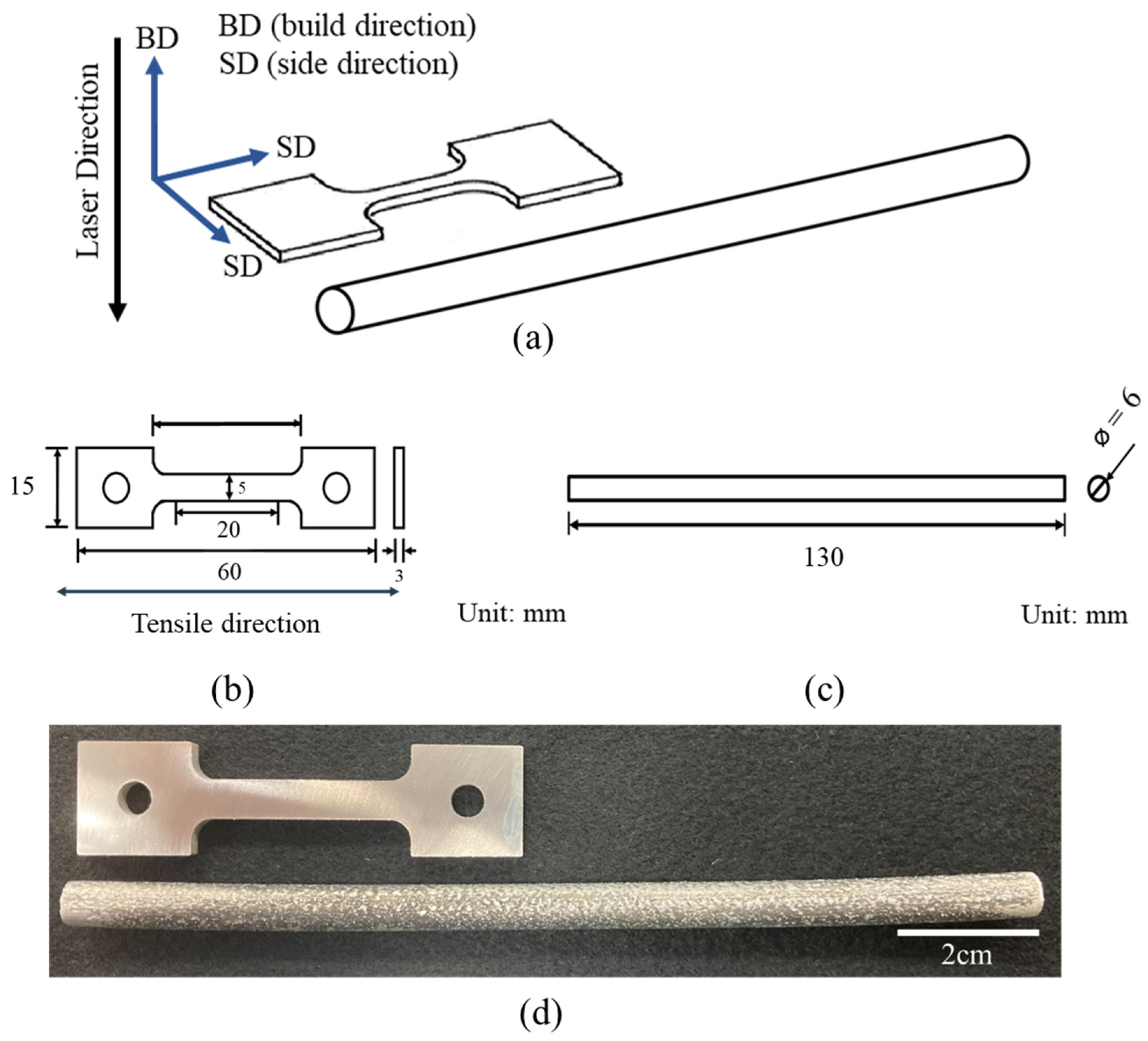
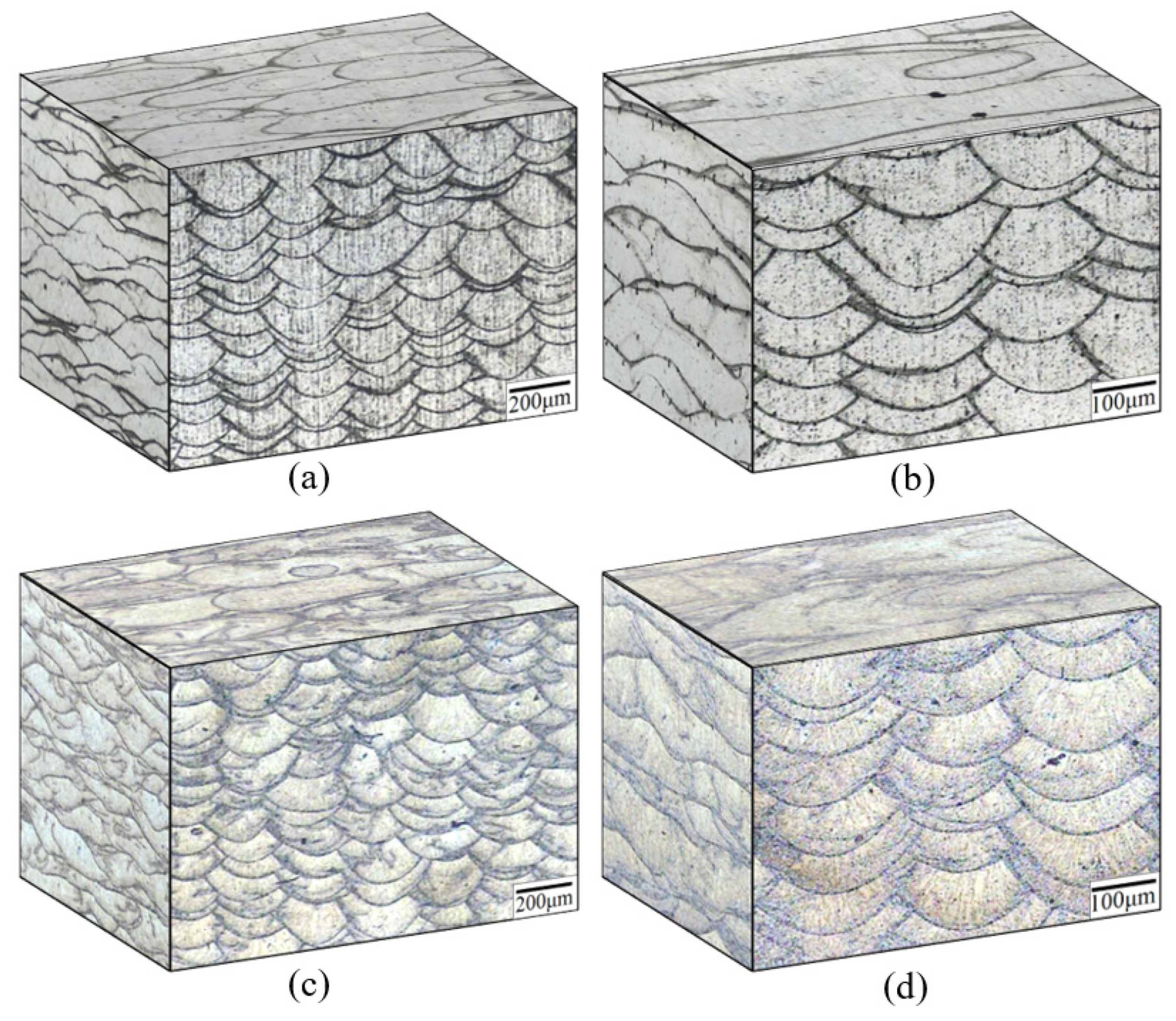
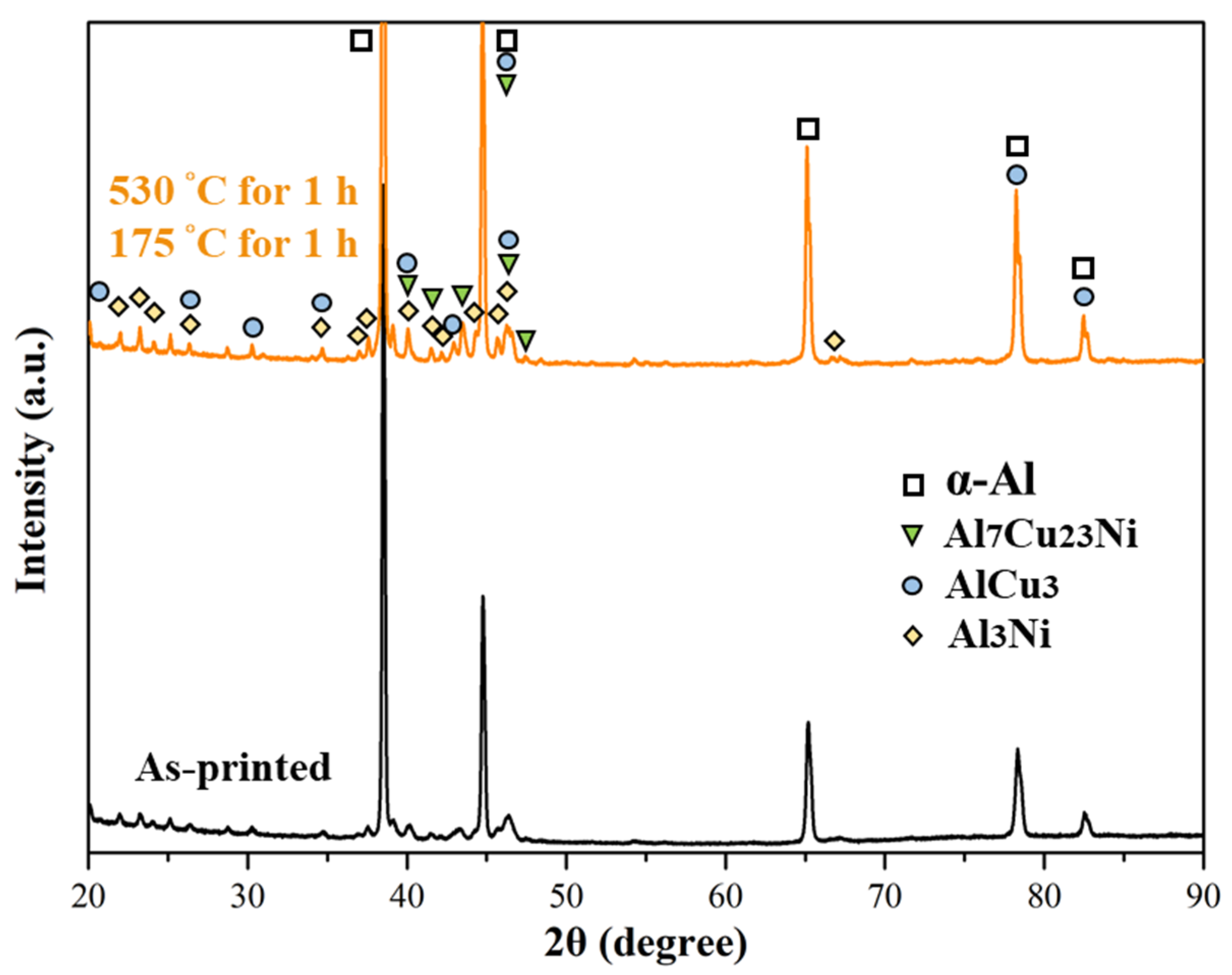
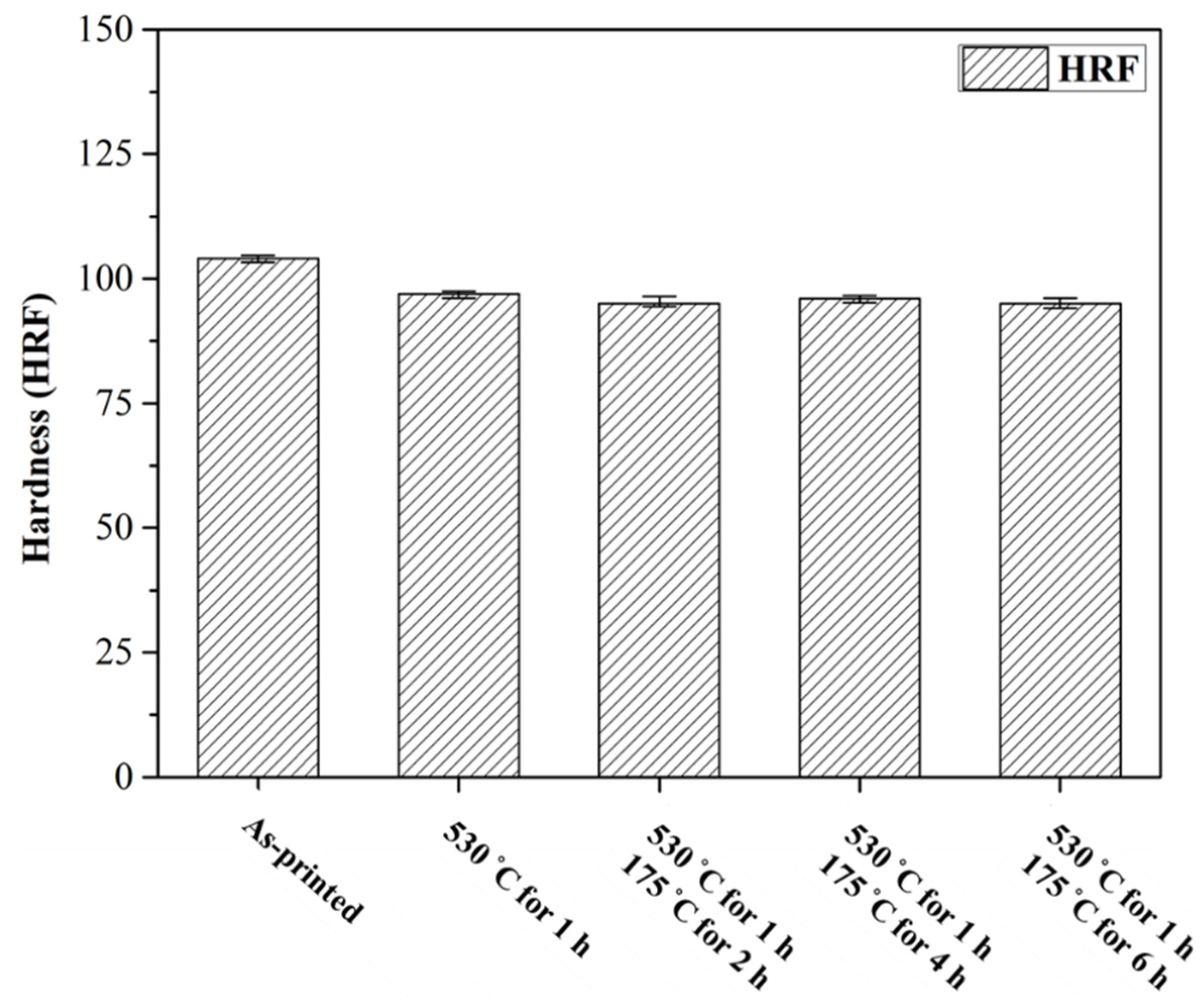
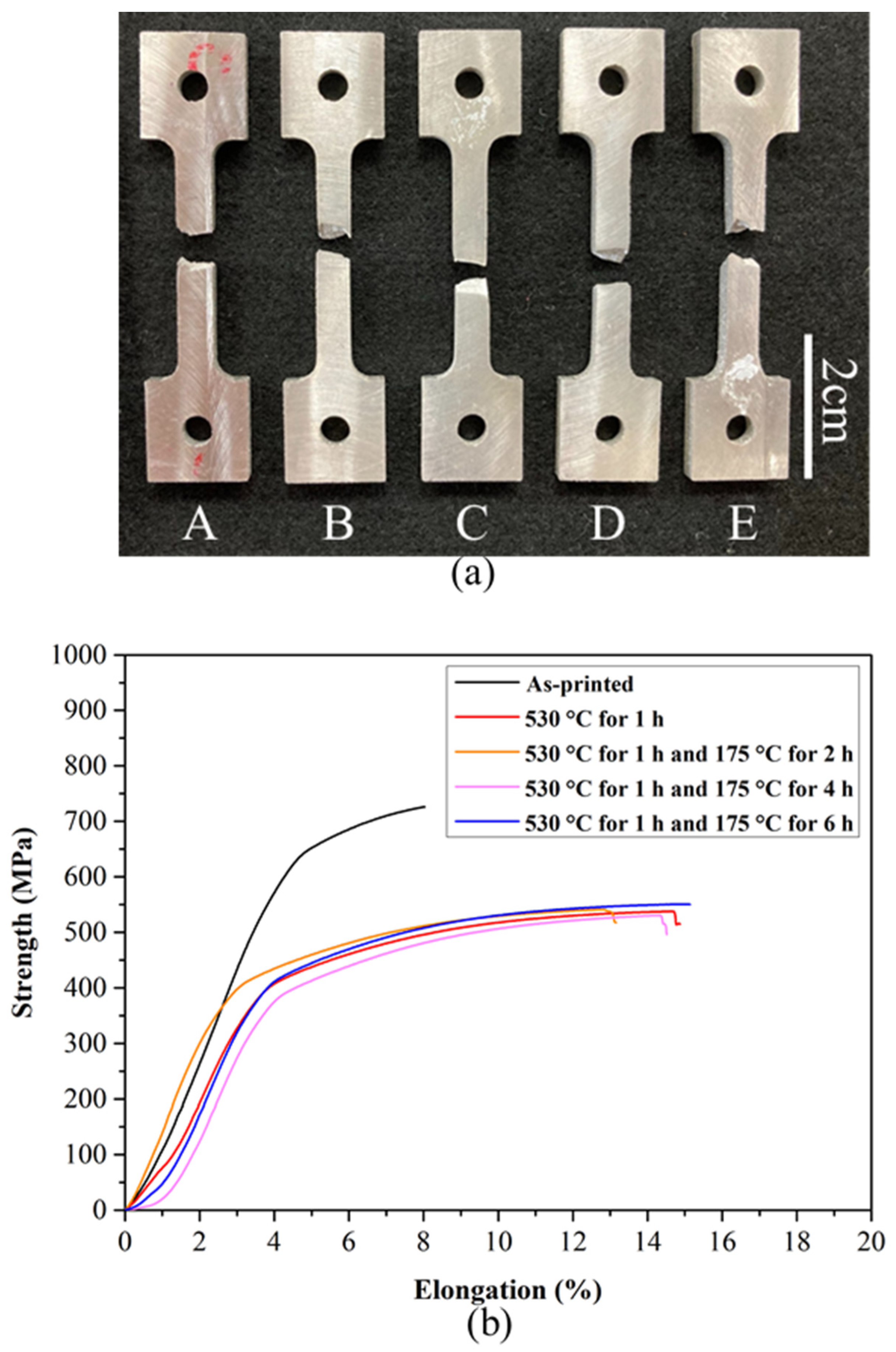

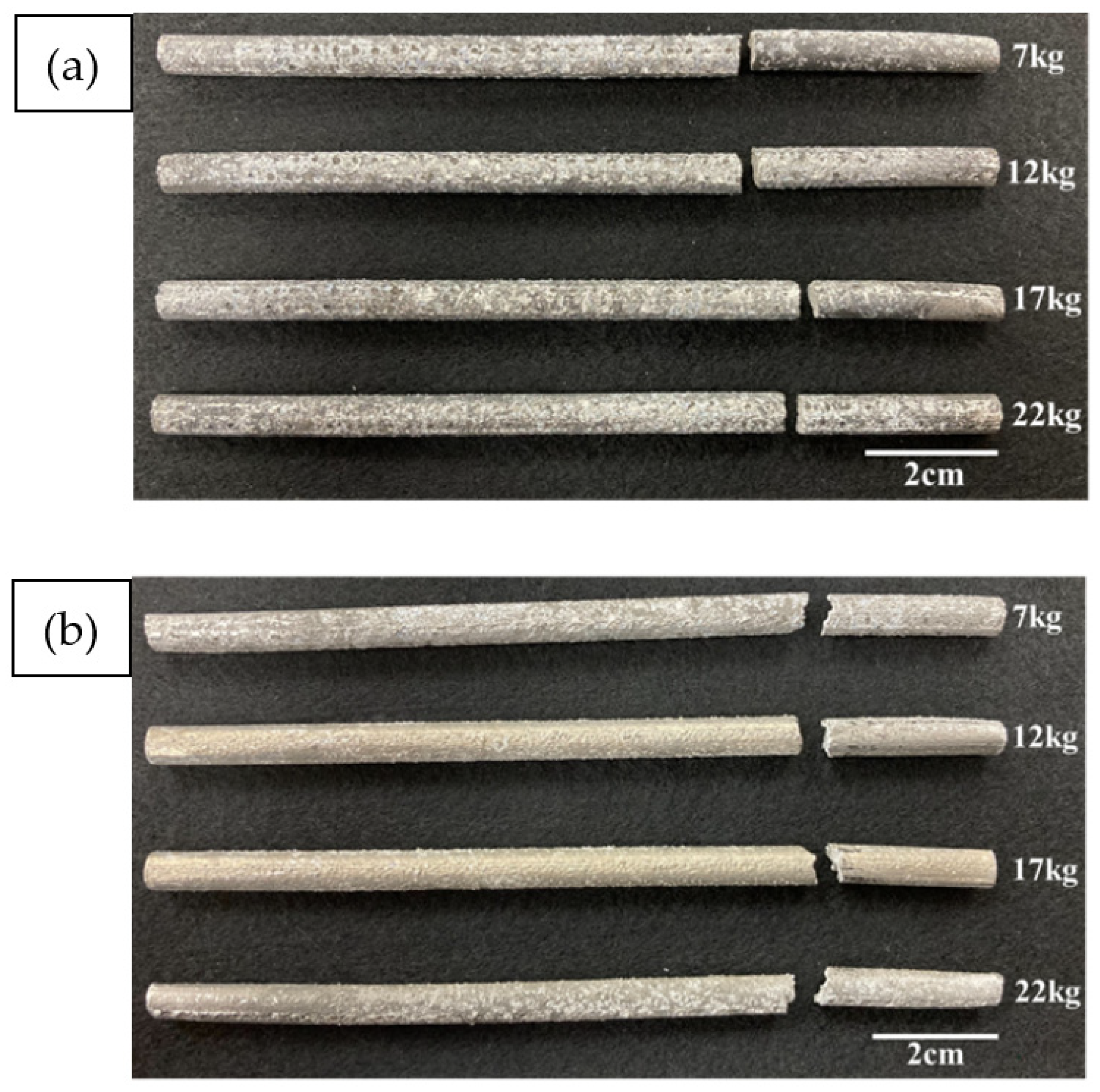
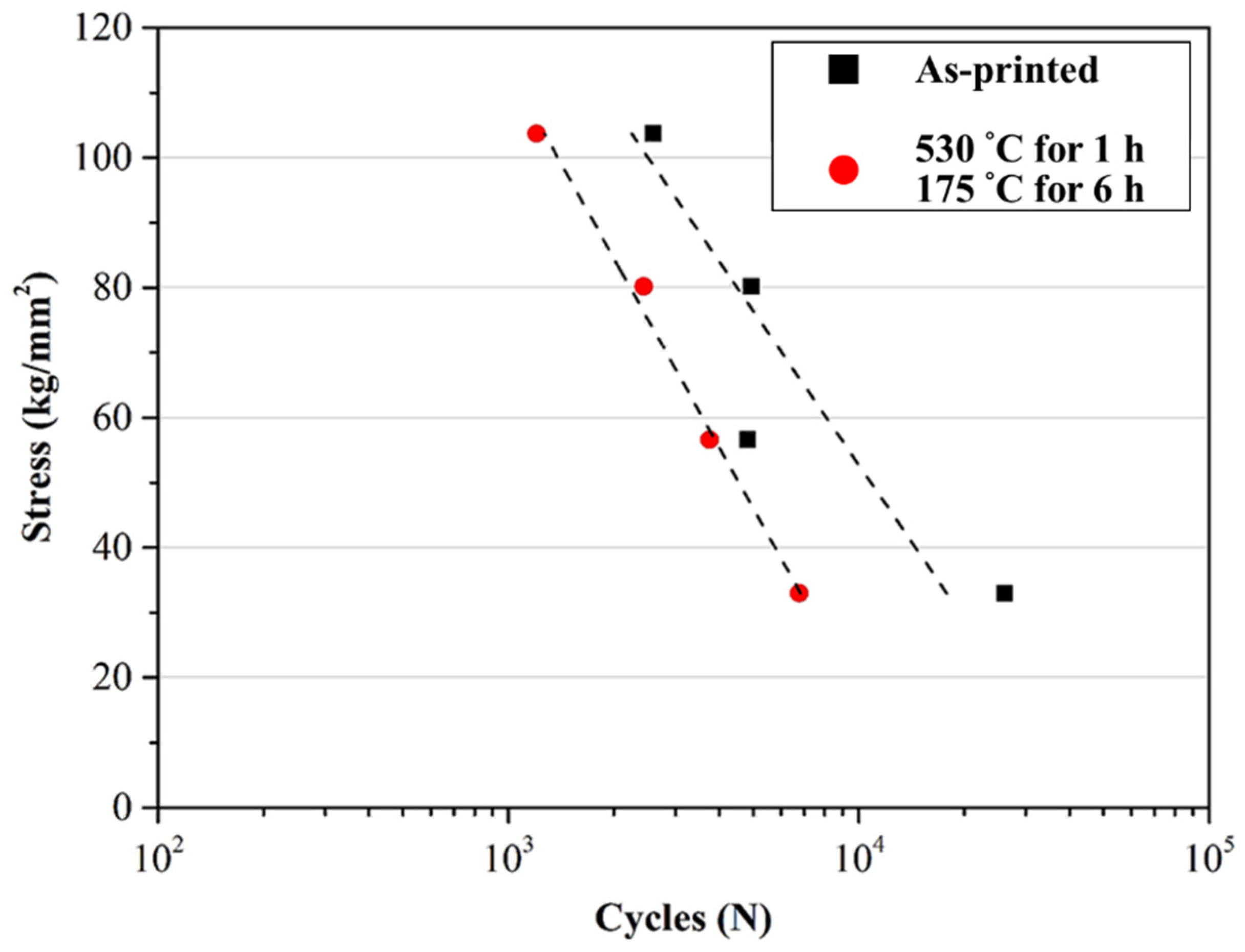
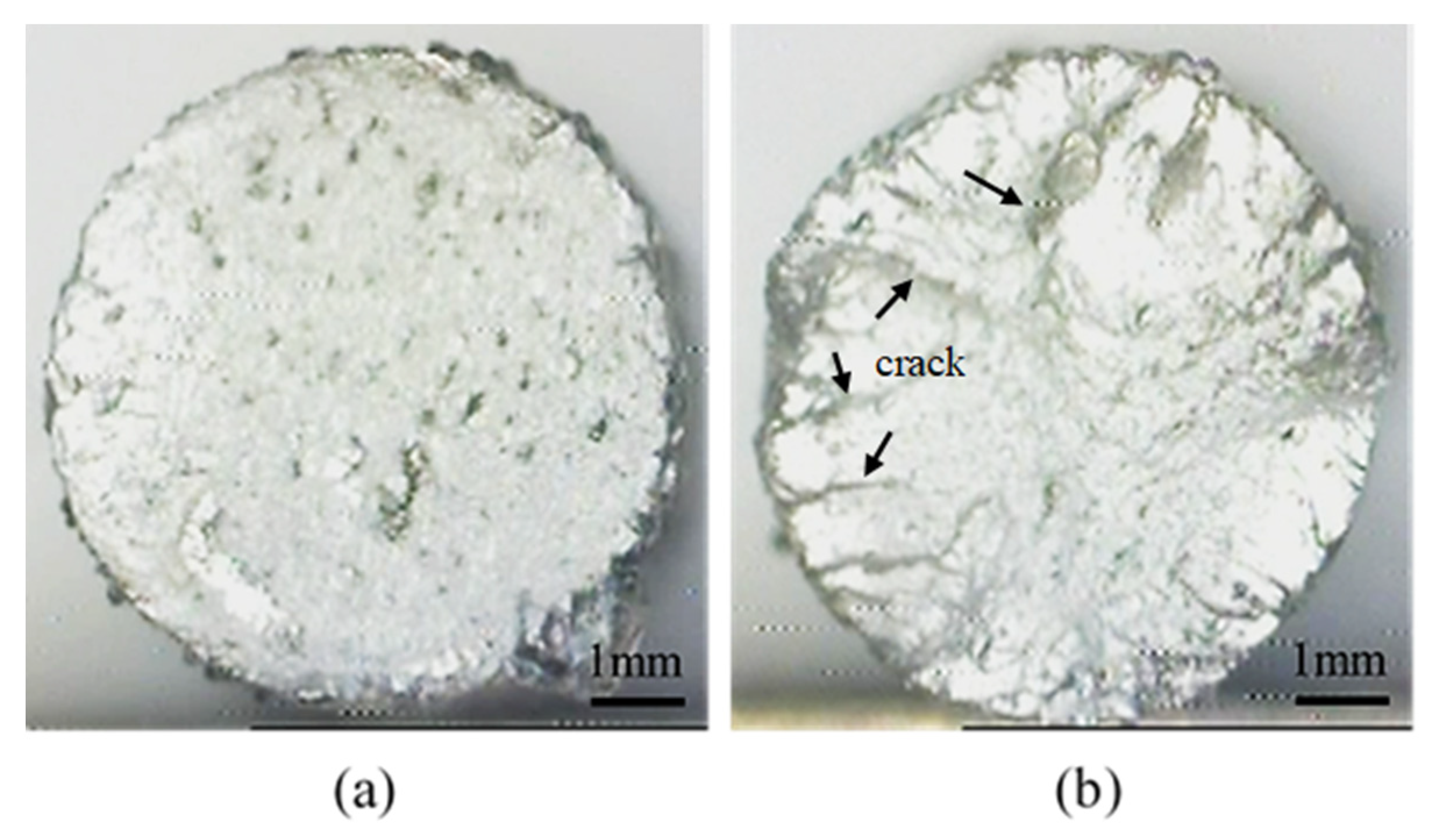

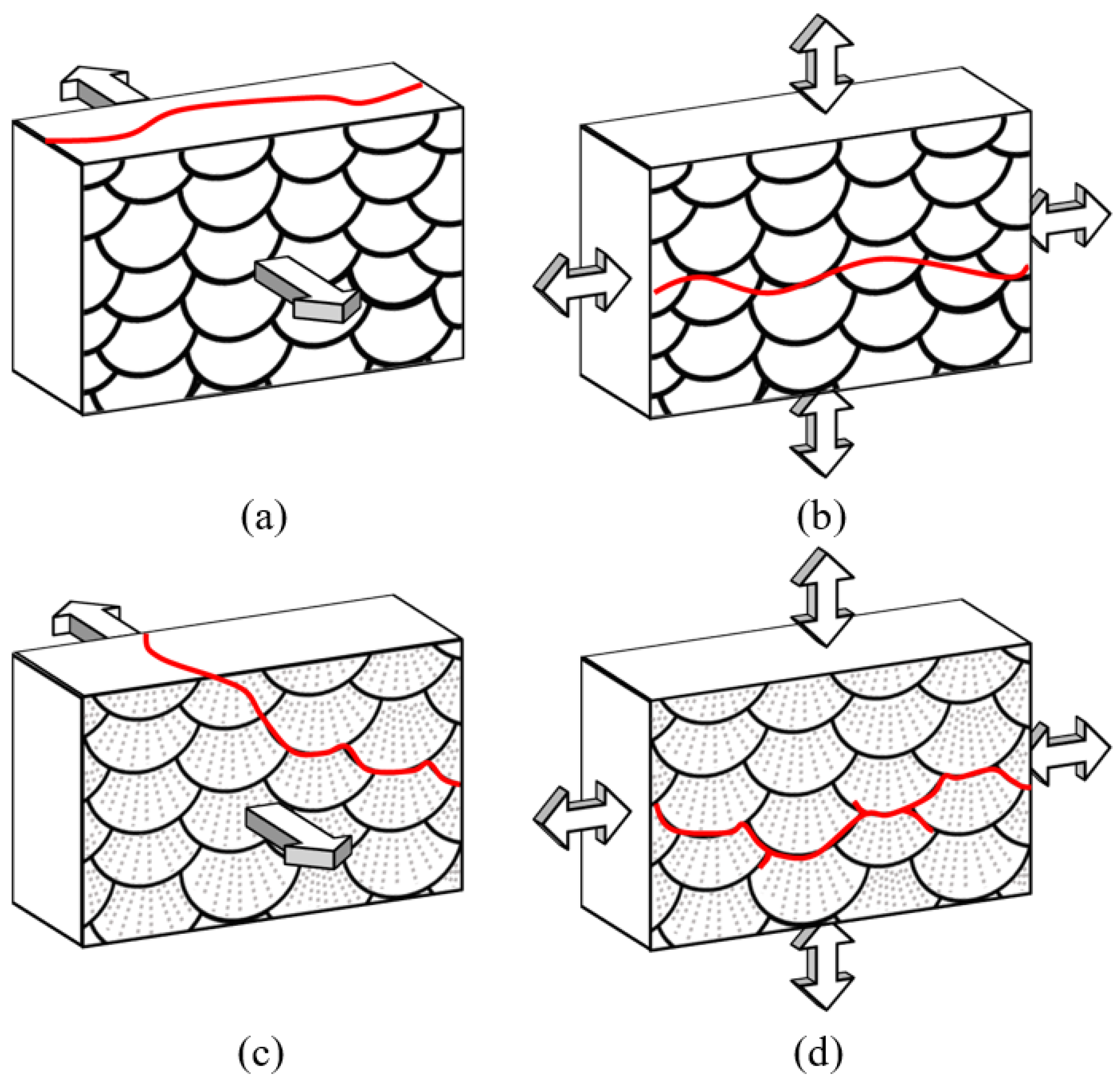
| Laser Power | Scanning Speed | Beam Size | Hatch Space | Layer Thickness |
|---|---|---|---|---|
| 300 W | 700 mm/s | 35 μm | 100 μm | 30 μm |
| Element | Al | Ni | Cu | Fe | Mn | Zr | Cr | Sc |
|---|---|---|---|---|---|---|---|---|
| wt.% | Balance | 3.8–4.2 | 1.9–2.2 | 1.2–1.5 | 0.6–0.8 | 0.6–0.8 | 0.45–0.55 | 0.12–0.2 |
| Element | Si | Mg | Zn | Ti | Sn | V | Be | Pb |
| wt.% | ≤0.1 | ≤0.05 | ≤0.05 | ≤0.05 | ≤0.05 | ≤0.05 | ≤0.05 | ≤0.05 |
| A | As-printed |
| B | 530 °C for 1 h |
| C | 530 °C for 1 h and 175 °C for 2 h |
| D | 530 °C for 1 h and 175 °C for 4 h |
| E | 530 °C for 1 h and 175 °C for 6 h |
| - | YS (MPa) | UTS (MPa) | UE (%) | TE (%) | HRF |
|---|---|---|---|---|---|
| A | 578 | 725 | 3.1 | 3.1 | 104 |
| B | 373 | 537 | 9.8 | 10.3 | 97 |
| C | 352 | 540 | 9.2 | 9.7 | 95 |
| D | 376 | 527 | 8.9 | 9.4 | 96 |
| E | 378 | 550 | 10.1 | 10.4 | 95 |
| Load (kg) | Stress (kg/mm²) | N (Number of Cycles to Failure) |
|---|---|---|
| As-printed | ||
| 7 | 33 | 26090 |
| 12 | 56.6 | 4811 |
| 17 | 80.2 | 4936 |
| 22 | 103.7 | 2591 |
| 530 °C for 1 h and 175 °C for 6 h | ||
| 7 | 33 | 6767 |
| 12 | 56.6 | 3754 |
| 17 | 80.2 | 2436 |
| 22 | 103.7 | 1204 |
Publisher’s Note: MDPI stays neutral with regard to jurisdictional claims in published maps and institutional affiliations. |
© 2021 by the authors. Licensee MDPI, Basel, Switzerland. This article is an open access article distributed under the terms and conditions of the Creative Commons Attribution (CC BY) license (http://creativecommons.org/licenses/by/4.0/).
Share and Cite
Chang, K.-C.; Zhao, J.-R.; Hung, F.-Y. Microstructure, Mechanical Properties, and Fatigue Fracture Characteristics of High-Fracture-Resistance Selective Laser Melting Al-Ni-Cu Alloys. Metals 2021, 11, 87. https://doi.org/10.3390/met11010087
Chang K-C, Zhao J-R, Hung F-Y. Microstructure, Mechanical Properties, and Fatigue Fracture Characteristics of High-Fracture-Resistance Selective Laser Melting Al-Ni-Cu Alloys. Metals. 2021; 11(1):87. https://doi.org/10.3390/met11010087
Chicago/Turabian StyleChang, Kai-Chieh, Jun-Ren Zhao, and Fei-Yi Hung. 2021. "Microstructure, Mechanical Properties, and Fatigue Fracture Characteristics of High-Fracture-Resistance Selective Laser Melting Al-Ni-Cu Alloys" Metals 11, no. 1: 87. https://doi.org/10.3390/met11010087





